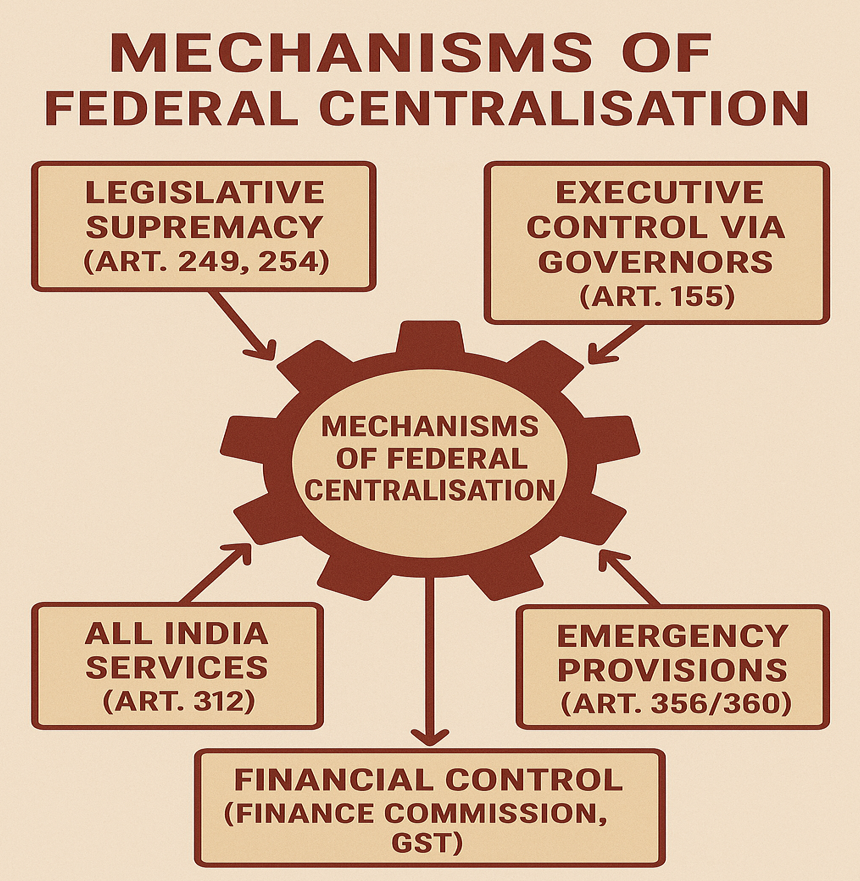There are no items in your cart
Add More
Add More
| Item Details | Price | ||
|---|---|---|---|
Mon Jun 30, 2025
పరిచయం:
భారతదేశం, విభజన తర్వాత ఐక్యత మరియు సమగ్రతను పెంపొందించడానికి, రాజ్యాంగంలోని 1వ అధికరణ లో "రాష్ట్రాల సమాఖ్య"గా వర్ణించబడిన ఒక ప్రత్యేకమైన సమాఖ్య విధానాన్ని స్వీకరించింది. డాక్టర్ బి.ఆర్. అంబేద్కర్ చెప్పినట్లుగా, భారతీయ సమాఖ్య వ్యవస్థ అమెరికా సమాఖ్య విధానం కంటే కెనడా యొక్క కేంద్రీకృత సమాఖ్య నమూనా నుండి ప్రేరణ పొంది, విచ్ఛిన్నం కాని విధంగా రూపొందించబడింది.
విషయం:
ఎ. బలమైన కేంద్ర ప్రభుత్వ రూపకల్పనకు కారణాలు
1. విభజన తర్వాత అభద్రత మరియు వేర్పాటువాద బెదిరింపులు
a. విభజన అనంతరం కోపంతో ఉన్న వారసత్వం మరియు సంస్థానాల సంక్లిష్టమైన సమైక్యత దేశ విచ్ఛిన్నత భయాలను సృష్టించాయి.
b. రాజ్యాంగ రచయితలు విచ్ఛిన్నతను నిరోధించడానికి ఏకాత్మక ధోరణిని ఇష్టపడ్డారు.
c. "రాష్ట్రాల సమాఖ్య" అనే పదం అమెరికా నమూనా వలె కాకుండా, అవిచ్చిన్న సమాఖ్యవాదాన్ని సూచిస్తుంది.
2. భాషాపరమైన మరియు సామాజిక-సాంస్కృతిక వైవిధ్యం
a. భారతదేశం యొక్క విస్తృత జాతి, భాషా, మరియు మతపరమైన వైవిధ్యం బలమైన జాతీయ సమైక్యతను కోరింది.
b. 1956లో భాషాపరమైన రాష్ట్రాల పునర్వ్యవస్థీకరణ మరియు హిందీ ఆధిక్యతను నిరోధించడంలో కేంద్రం స్థిరీకరణ పాత్ర పోషించింది.
c. ఐక్యతతో వైవిధ్యాన్ని సమతుల్యం చేయడాన్ని లక్ష్యంగా పెట్టుకుంది.
3. కెనడా సమాఖ్యవాదం యొక్క ప్రభావం
a. అమెరికా యొక్క "సమైక్యత-ఆధారిత" నమూనా వలే కాకుండా, కెనడా యొక్క "విచ్ఛిన్నత-ఆధారిత" సమాఖ్య నుండి ప్రేరణ పొందబడింది.
b. రాష్ట్రాల పునర్వ్యవస్థీకరణతో సహా కేంద్రం రాష్ట్రాలపై ఏకపక్ష అధికారాలను కలిగి ఉంటుంది.
c. రెండు దేశాలూ అధికారిక పరిభాషలో "సమాఖ్య" అనే పదాన్ని ఉపయోగిస్తాయి.
4. జాతీయ రాజకీయ నాయకత్వ ఆధిపత్యం
a. కాంగ్రెస్ ప్రభుత్వం నెహ్రూ ఆధ్వర్యంలో అంతర్గత సమాఖ్యవాదాన్ని సాధ్యం చేసింది.
b. ఇందిరా గాంధీ హయాంలో తర్వాతి దశలు కేంద్రీకరణ ధోరణులను చూపాయి (ఉదా., కేరళ తొలగింపు 1959).
c. 2014 తర్వాతి కాలం ఆధిపత్య సమాఖ్యవాదాన్ని ప్రతిబింబిస్తుంది. కేంద్రం-రాష్ట్రాల శక్తి గతిశీలతను పునర్నిర్మిస్తుంది.
బి. సమాఖ్యను బలోపేతం చేసే రాజ్యాంగ నిబంధనలు
1. శాసనాధికారాల అసమాన పంపిణీ
a. కేంద్ర జాబితా, రాష్ట్ర జాబితా కంటే ఎక్కువ అంశాలను కలిగి ఉంది. అలాగే 254 అధికరణ ద్వారా ఉమ్మడి జాబితాపై కేంద్రానికి ఆధిపత్యం ఇస్తుంది.
b. 249 అధికరణ కింద, జాతీయ అత్యవసర పరిస్థితి కాలంలో రాజ్యసభ తీర్మానంతో రాష్ట్ర అంశాలపై పార్లమెంటు చట్టాలు చేయవచ్చు.
2. రాష్ట్రాల పునర్వ్యవస్థీకరణ అధికారం
a. 3వ అధికరణ పార్లమెంటుకు రాష్ట్రాలను సృష్టించడం, విలీనం చేయడం లేదా పేరు మార్చడం వంటి ఏకపక్ష అధికారాలను ఇస్తుంది.
b. తెలంగాణ ఆవిర్భావం (2014) మరియు జమ్మూ-కాశ్మీర్ పునర్వ్యవస్థీకరణ (2019)లో ఇది ఉపయోగించబడింది.
c. రాష్ట్రాలకు వేర్పాటు హక్కు లేదు.
3. కార్యనిర్వాహక యంత్రాంగంపై నియంత్రణ
a. గవర్నర్లను రాష్ట్రపతి నియమిస్తారు(155వ అధికరణ) మరియు వారు కేంద్ర ప్రతినిధులుగా వ్యవహరిస్తారు.
b. అఖిల భారత సర్వీసుల (ఆర్టికల్ 312) ద్వారా కేంద్రం రాష్ట్రాలపై సిబ్బంది నియంత్రణను కలిగి ఉంటుంది.
4. అత్యవసర అధికారాలు మరియు అతిక్రమణ నిబంధనలు
a. 356 అధికరణ ప్రకారం, కేంద్రం రాష్ట్రాలలో రాష్ట్రపతి పాలనను విధించవచ్చు.
b. 360 అధికరణ ఆర్థిక అత్యవసర పరిస్థితిని అనుమతిస్తూ, పార్లమెంటుకు ఆధిపత్యం ఇస్తుంది.
c. ఎస్.ఆర్. బొమ్మై కేసు (1994) ఏకపక్ష తొలగింపుపై పరిమితులను విధించినప్పటికీ, ఈ నిబంధన యొక్క చెల్లుబాటును సమర్ధించింది.
5. ఆర్థిక కేంద్రీకరణ
a. ఆర్థిక సంఘం కేంద్ర రాష్ట్రాల మధ్య ఆర్థిక వనరులను పంపిణీ చేస్తుంది కానీ, పన్ను విధింపు అధికారాలు కేంద్రానికి అనుకూలంగా ఉంటాయి.
b. జీఎస్టీ విధానం పరోక్ష పన్నులను కేంద్రీకరించింది. జీఎస్టీ కౌన్సిల్ తరచూ కేంద్రం యొక్క బలాన్ని ప్రతిబింబిస్తుంది.
c. రాష్ట్రాలు కేంద్ర గ్రాంట్లు మరియు సహకారంపై ఎక్కువగా ఆధారపడతాయి.

ముగింపు
భారతదేశం యొక్క సమాఖ్య విధానం కేంద్రీకరణ ధోరణితో ఆవిర్భవించినప్పటికీ, దాని ప్రజాస్వామిక చైతన్యం ఇప్పుడు సహకార సమాఖ్యవాదం వైపు మార్పును కోరుతోంది. బలవంతపు కేంద్రీకరణను అధిగమించి, అంతర్రాష్ట్ర మండలి, జీఎస్టీ కౌన్సిల్, మరియు నీతి ఆయోగ్ వంటి వేదికలు ఉమ్మడి పాలనా వేదికలుగా పరిణామం చెంది, రాజ్యాంగ సమాఖ్యవాదం యొక్క స్ఫూర్తిని నెరవేర్చాలి.